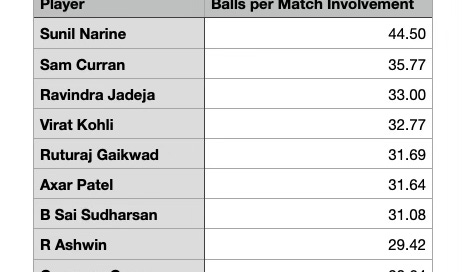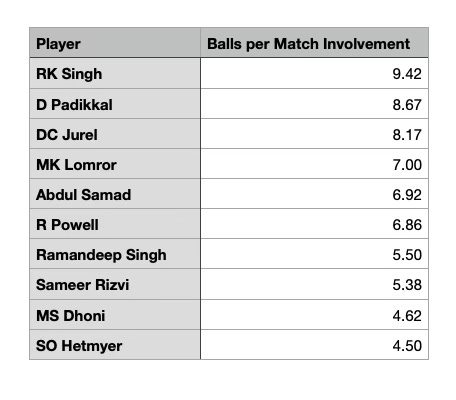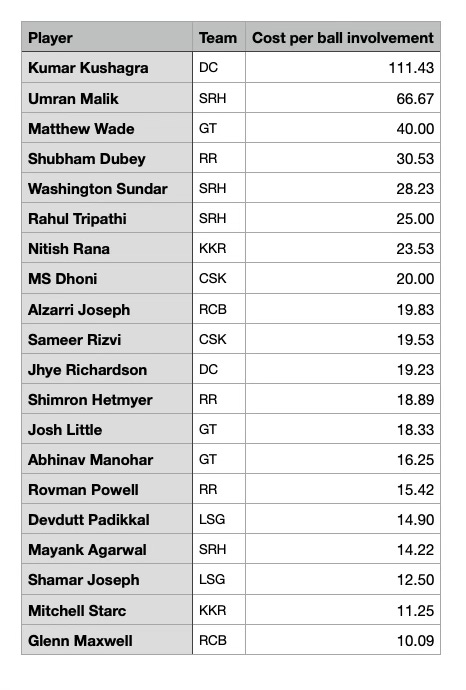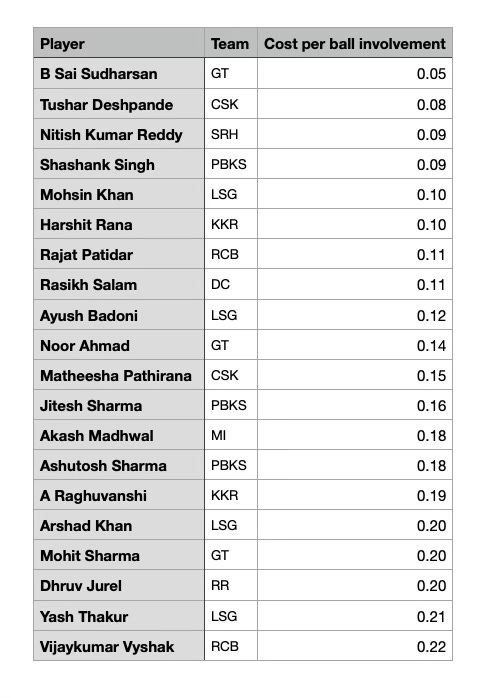IPL Auctions - Market Dynamics Series Part 4 - Quantifying per ball value
Understanding match involvement for player dynamics and roles...
As this IPL market dynamics series continues, I want to start talking in depth about match involvement in the IPL.
It might not be perfect, because it doesn’t take into account fielding or wicket-keeping value, but the simple way to look at per match involvement is:
(balls batted + balls bowled)/number of matches played
Looking at the players who feature in the top 10 match involvement players in the IPL this year (minimum 5 matches played), here’s a list:
What do you notice about the list?
Basically there are two types of player on this list. All-rounders (Narine, Curran, Jadeja, Axar, Ashwin, Green and to a limited extent, Parag) and batters who are generally perceived to be stability-oriented/anchors (Kohli, Gaikwad, Sai Sudharsan).
Focusing on Sunil Narine, he’s directly been involved in 44.50 balls per match, out of the maximum 240 in a match (average balls per match is lower than 240, because not all innings last for 20 overs). Even if we assumed KKRs matches all featured 240 balls, when he plays, Narine is directly influencing 18.54% of balls for his franchise. He’s having a direct impact on almost 1/5th of the balls in the entire match.
Even with the impact sub rule arguably negating the effect of all-rounders slightly, we still see the top three balls per match involvement players all being all-rounders. A decent chunk of the next 10 highest match involvement players also feature all-rounders in some way, shape or form (Cummins, Rashid Khan, Hardik Pandya, Marcus Stoinis).
While scarcity of resources is a major factor (we’ve discussed this in previous articles), this starts to give some additional reasoning as to why all-rounders are so valued at auction - they directly impact a higher percentage of balls in the match than other types of playing roles.
Now let’s take a look at the players this year in the IPL with the lowest balls per match involvement:
What do you notice about the list?
The majority of these players are finishers (Rinku Singh, Jurel, Lomror, Samad, Powell, Ramandeep, Dhoni) or out of form batters (Padikkal and Hetmyer). We have to go to number 29 in the least balls per match involvement list to find a player primarily selected for his bowling (Mayank Dagar), and even Dagar is involved for 14.40 balls per match.
In short, then, if you’re a finisher or a wicket-keeper batting low down the order, you’ve got to be able to add so much value at finishing and/or keeping compared to the average player in your role in order to be value for money at sizable prices at auction. However, quite a few of these players weren’t cheap - another potential market inefficiency in the IPL auction room.
Now we’re on the subject of cost, let’s move on to cost (lakh) per ball involvement. This is going to make a few readers heads spin…
Yes, Kumar Kushagra has cost over 1 Crore per ball involvement this season. Quite incredible.
While there is a few injured players on the list, I do think that the list generally illustrates the absolute necessity to ensure 1) that players recruited or retained for reasonable/high cost have a clear role to play in your squad and 2) that this represents decent value for money.
Could DC, for example, have not signed Kushagra and spent some of that 7.8 Cr on the best analytics department in the tournament? We’ve already spoken in previous articles in this series about taking a ‘win now’ approach one year before the mega auction being a far more optimal approach than having taking an expensive punt on young talent.
On the flip side, the list of players with lowest cost (lakh) per ball involvement shows the value of good scouting:-
With investment in youth academies relatively poor value in the IPL due to the nature of the auction cycle and lack of transfer market between teams (teams can’t sell players for profit), IPL franchises would be better served throwing as much resource as possible into analytics and scouting.
The evidence above, showing the tiny cost per ball involvement for these players, is clear - the costs involved to have the best analytics and scouting department in the IPL is probably the best value for money that a team can spend.
These 20 players above have cost barely any money per ball involvement, and finding them represents huge value to any team. Notice one thing though - most of these players are young and/or have very low levels of experience at IPL level.
Once a core group of 15-16 players has been established for a squad, recruiting the rest of the squad in line with diligently scouted young players makes total sense. This isn’t always the case though - the number of older players bought for between 20-50 lakh shows teams don’t always heed this assertion.
As far as I know, this type of match involvement analysis (both as a player role, and as a cost per ball involvement) hasn’t been covered by anyone else in the public domain yet, so I do hope you found this type of content useful.
Anyone interested in discussing how I can help their team with strategic management and data-driven analysis, or contribute to any media work, can get in touch at sportsanalyticsadvantage@gmail.com.






